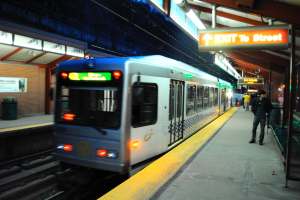A disconnect to economic opportunity
Posted on 04/07/15 by in Transit

A majority of poor people and minorities now live in the suburbs—isolated from jobs, services and the transportation needed to access them—according a recent report from the Brookings Institution.
The report, entitled “The Growing Distance Between People and Jobs in Metropolitan America,” also shows the Cleveland metropolitan area is the worst offender in the country when it comes to declining job density and longer commutes. Between 2000 and 2012, there was a 26.5 percent decline in the number of jobs in the Cleveland metro area near the typical resident. Dayton and Toledo metros are also on the top-ten offender list.
Why does job proximity matter? Given Ohio’s sorry state of public transit, commuters are forced to rely on cars to get around, and cars are expensive—expensive to own and expensive to operate and maintain. For low-income Ohioans, they can be prohibitively expensive. And for poor workers, this can mean the difference between getting and keeping a job. In Ohio, more than 8 percent of households have no access to a vehicle. One in five African-American households in Ohio do not have access to a car. Transportation is a critical link in the economic opportunity chain, and the backbone of our economy. The state of Ohio rightly spends billions of public dollars each year to invest in our transportation infrastructure in order to keep people and goods moving. However, for decades, we have disproportionately invested in Ohio’s roads and highway and marginalized public transit, creating a sprawling transportation system that is inequitable and inhospitable for low-income families and people of color.
Transportation is a critical link in the economic opportunity chain, and the backbone of our economy. The state of Ohio rightly spends billions of public dollars each year to invest in our transportation infrastructure in order to keep people and goods moving. However, for decades, we have disproportionately invested in Ohio’s roads and highway and marginalized public transit, creating a sprawling transportation system that is inequitable and inhospitable for low-income families and people of color.
Equal opportunity demands affordable and accessible transportation options. This excellent editorial in the Toledo Blade outlines what Gov. Kasich and Ohio’s General Assembly should have done last week when they passed into law the latest multi-billion transportation budget. Yet again, fewer than 1 percent of Ohio’s transportation budget was allocated for public transit. Instead, the state legislature decided to commission another study. This issue has been studied, then studied again. Now we going to do some more studying.
Maybe its time for the courts to step in and require equal access for the transportation disadvantaged. Anyone know a good lawyer?
-- Amanda Woodrum
